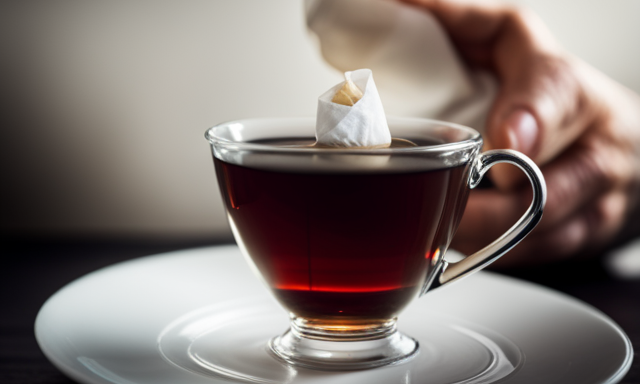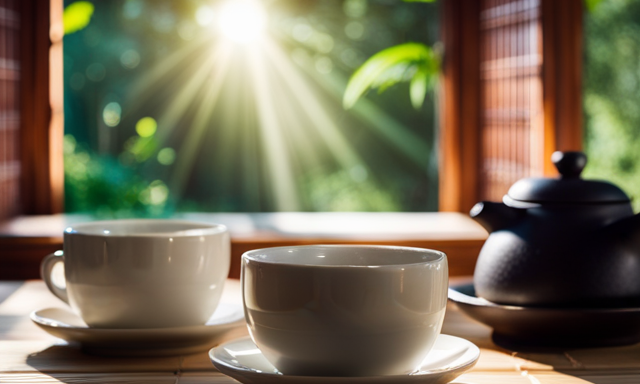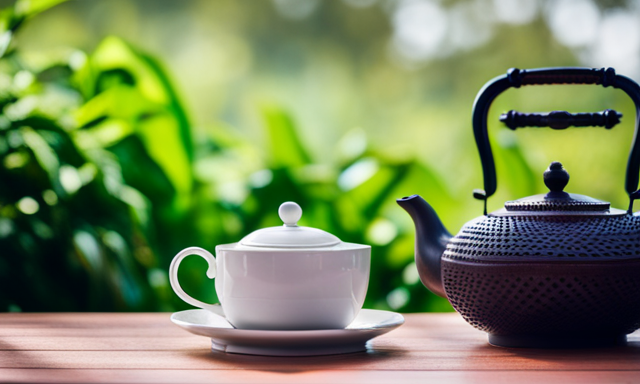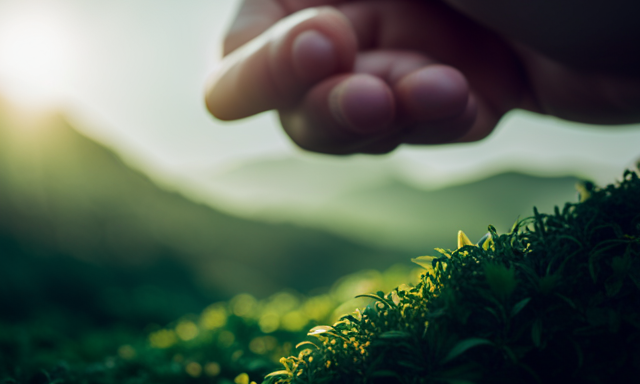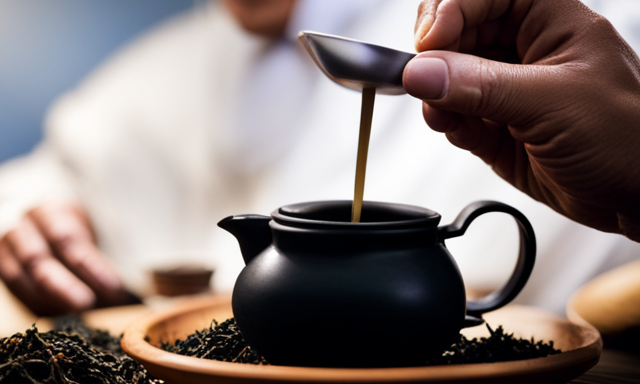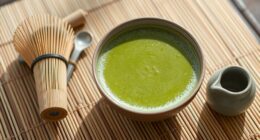Do you enjoy tea as much as I do? If so, you’re in luck because today I will be demonstrating how to properly prepare oolong tea bags. With a few easy steps, you can savor the delightful and aromatic taste of this well-loved tea. Let’s begin!
First, gather your supplies. You’ll need oolong tea bags, boiling water, and a tea infuser or teapot. Once you have everything ready, boil the water to the perfect temperature for oolong tea.
Next, prepare your tea infuser or teapot by placing the oolong tea bag inside. Pour the hot water over the tea bag and let it steep for a few minutes. Finally, remove the tea bag, give it a gentle squeeze to release any excess liquid, and voila! You’re ready to enjoy a perfectly brewed cup of oolong tea.
But don’t stop there! Feel free to experiment with enhancements like honey, lemon, or even a splash of milk. The choice is yours.
So sit back, relax, and savor the delightful experience of oolong tea.
Key Takeaways
- Boil water to the right temperature for oolong tea
- Choose the right oolong tea variety
- Ensure the tea infuser or teapot is clean and suitable for oolong tea
- Steep the tea for 3-5 minutes
Gather Your Supplies
Now let’s grab all the supplies we need to make a perfect cup of oolong tea! The first thing we need is high-quality oolong tea bags. There are many tea bag brands available in the market, so choose one that suits your taste preferences.
Oolong tea comes in different types, such as green oolong, black oolong, and floral oolong. Each type has its unique flavor profile, so feel free to experiment and find your favorite.
Once you have your tea bags, you’ll also need a teapot or a mug, a kettle or a pot to boil water, and a timer to ensure the perfect steeping time.
Now that we have all our supplies ready, let’s move on to the next step of boiling water to the right temperature for brewing our oolong tea.
Boil Water to the Right Temperature
First, start by heating your water to the perfect temperature for a flavorful cup of oolong tea. Water temperature control is crucial for achieving the best taste and aroma. Boiling techniques play a significant role in this process. To ensure the ideal temperature, refer to the table below:
| Water Temperature | Description |
|---|---|
| 180°F | Light and floral oolong tea |
| 190°F | Medium-bodied oolong tea |
| 200°F | Full-bodied and robust oolong tea |
Carefully monitor the water while it boils, as overheating can result in a bitter taste. Once the water reaches the desired temperature, remove it from the heat source. This will allow the water to cool slightly before brewing the tea. Now that the water is ready, let’s move on to preparing your tea infuser or teapot to continue the oolong tea preparation process.
Prepare Your Tea Infuser or Teapot
To get the best flavor from your oolong tea, all you need to do is make sure your tea infuser or teapot is ready for the brewing process. Here are a few things to keep in mind:
-
Infuser cleaning: Before preparing your oolong tea, make sure your tea infuser is clean and free from any leftover residue. This ensures a pure and untainted flavor.
-
Different tea varieties: Oolong tea comes in different varieties, each with its own unique flavor profile. Be sure to choose an infuser or teapot that’s suitable for the specific type of oolong tea you’re using, as this can enhance the overall taste experience.
-
Proper size: Ensure that your infuser or teapot is the right size for the amount of tea you want to brew. This allows for optimal water circulation and extraction of flavors.
-
Material matters: Consider the material of your infuser or teapot. Stainless steel or ceramic options are often preferred for oolong tea, as they don’t interfere with the taste.
Once your tea infuser or teapot is ready, it’s time to place the oolong tea bag in it and continue with the brewing process.
Place the Oolong Tea Bag in the Infuser or Teapot
Once you’ve chosen the perfect vessel, gently place the delicate tea leaves into the infuser or teapot, allowing the anticipation to bloom like a freshly blossomed flower.
Oolong tea, known for its complex flavors and numerous health benefits, requires the right brewing technique to fully appreciate its nuances. By carefully placing the oolong tea bag in the infuser or teapot, you ensure that the hot water can effectively extract the tea’s rich flavors and aromas. The tea leaves need room to expand and release their natural goodness, so make sure not to overcrowd the infuser or teapot.
Once the tea bag is in place, you can move on to the next step of pouring the hot water over it, allowing the infusion process to begin.
Pour the Hot Water Over the Tea Bag
As you pour the hot water over the tea bag, watch as the magic unfolds and the flavors dance in harmony, creating a symphony of taste that’ll transport you to a world of tranquility.
-
The hot water temperature is crucial for extracting the perfect flavors from the oolong tea leaves.
-
The steam rises, carrying the tantalizing aroma of the tea, enveloping your senses and preparing you for the delightful experience ahead.
-
The water seeps into the tea bag, initiating the steeping process and allowing the leaves to release their full potential.
-
The rich amber color gradually infuses the water, indicating that the tea’s absorbing the hot water’s essence.
With the hot water fully integrated, it’s time to steep the tea for the recommended time, allowing the flavors to develop and intensify.
Steep the Tea for the Recommended Time
Allow the tea to steep for the recommended time, allowing its flavors to develop and unfold, creating a sensory journey like no other.
Steeping time is crucial in determining the taste and strength of your oolong tea. It’s recommended to steep the tea for about 3 to 5 minutes. However, you can also experiment with different steeping times to find your preferred flavor profile.
Shorter steeping times result in a lighter, more delicate taste, while longer steeping times yield a stronger, bolder flavor. Oolong tea is known for its numerous health benefits, such as aiding in weight loss, improving digestion, and promoting heart health.
By steeping the tea for the recommended time, you can fully enjoy these benefits. Once the steeping time is complete, we can move on to removing the tea bag and squeezing out any excess liquid.
Remove the Tea Bag and Squeeze Out Excess Liquid
Take a moment to gently lift out the tea bag, feeling the weight of anticipation as you prepare to reveal the beautifully brewed oolong tea. The next step is to employ the squeeze technique, which helps extract every last drop of flavor from the tea bag. Before squeezing, let the tea bag cool down slightly to avoid burning yourself. Place the tea bag between your thumb and index finger, applying gentle pressure to release the remaining liquid. Be careful not to tear the bag or let any loose tea leaves escape. If you prefer not to squeeze the tea bag, there are alternative methods to extract the maximum flavor without using this technique. For example, you can gently press the tea bag against the side of the cup using a spoon. With the excess liquid squeezed out, you can now move on to enjoying your perfectly brewed oolong tea, savoring its rich aroma and delightful taste.
Enjoy Your Perfectly Brewed Oolong Tea
Indulge in the pleasure of sipping on your exquisitely steeped oolong tea, relishing the intricate flavors that dance on your taste buds.
To achieve the perfect oolong tea, it’s important to follow the right brewing techniques. Start by using high-quality oolong tea bags and steep them in hot water for around 3-5 minutes, depending on your desired strength. As the tea infuses, the distinctive aroma will fill the air, creating a serene atmosphere. Once steeped, remove the tea bag and squeeze out any excess liquid to ensure maximum flavor.
Now, take a moment to appreciate the numerous benefits of drinking oolong tea, such as improved digestion, enhanced brain function, and increased metabolism.
As we move forward, let’s explore how to experiment with enhancements to elevate your oolong tea experience.
Experiment with Enhancements
When it comes to enhancing the flavor of oolong tea, I recommend adding a touch of honey or sugar to sweeten it just right. This can help balance out any bitterness and bring out the natural flavors of the tea.
Another option to consider is adding a squeeze of lemon, which can add a refreshing citrus twist to your cup of oolong.
Lastly, if you prefer a creamy and smooth tea, try adding a splash of milk to create a luscious and indulgent experience.
Add honey or sugar
To enhance the natural sweetness of your oolong tea, simply stir in a dollop of honey or a sprinkle of sugar. This creates a symphony of flavors that will captivate your taste buds. Adding honey or sugar not only enhances the taste but also brings a host of health benefits. Honey is packed with antioxidants and has antibacterial properties that can boost your immune system and soothe a sore throat. Sugar, on the other hand, gives you a quick energy boost and can improve your mood.
If you’re looking for alternatives, you can try using stevia, a natural sweetener with zero calories, or agave syrup, which has a lower glycemic index. So go ahead and sweeten your oolong tea with honey, sugar, or any alternative of your choice.
In the next section, we’ll explore the option of adding lemon or milk for a delightful twist.
Try adding lemon or milk
Now that we’ve explored the option of adding honey or sugar to our oolong tea, let’s delve into other flavor enhancements.
One interesting way to elevate your oolong tea experience is by adding a squeeze of lemon or a splash of milk. These additions can bring out different dimensions of flavor in the tea, creating a unique taste profile.
Additionally, you can experiment with adding herbs or spices like mint, ginger, or cinnamon to infuse your oolong tea with additional aromatic notes. Don’t be afraid to get creative and try different combinations to find your perfect blend.
Another factor to consider is the steeping time. Different steeping times can result in varying levels of strength and flavor intensity, so feel free to adjust according to your preference.
Now, let’s move on to the next section and learn how to relax and savor your oolong tea experience.
Relax and Savor Your Oolong Tea Experience
Relax and savor your oolong tea experience, as it’s a delightful way to unwind.
Oolong tea not only offers a soothing taste but also provides numerous health benefits.
When preparing your tea bags, take a moment to engage in relaxation techniques such as deep breathing or meditation. This’ll enhance your overall tea experience and help you fully appreciate the calming effects it can have on your mind and body.
Oolong tea is known for its ability to reduce stress and anxiety, thanks to its natural compounds that promote relaxation. It also contains antioxidants that can boost your immune system and improve digestion.
So, while you sip your oolong tea, take time to appreciate the tranquility it brings and the positive impact it has on your well-being.
Frequently Asked Questions
How long should I boil the water for oolong tea?
To achieve the perfect brew, I suggest boiling the water for oolong tea until it reaches the temperature of a scorching summer day. This usually takes around 190-200°F, ensuring the ideal balance of flavors.
Can I reuse the oolong tea bag for a second steeping?
Yes, you can definitely reuse oolong tea bags for a second steeping. This not only saves money but also allows you to enjoy the benefits of a second infusion, such as a milder flavor and reduced caffeine content.
How many oolong tea bags should I use per cup of water?
For the perfect cup of oolong tea, steep one tea bag per cup of water. This allows the flavors to fully infuse, creating a rich and aromatic brew. Experiment with different brands to find your favorite.
What is the recommended storage method for oolong tea bags?
To ensure optimal freshness and flavor, the recommended storage method for oolong tea bags is to keep them in an airtight container away from moisture, light, and strong odors. This helps extend their shelf life.
Can I add milk or sweeteners to my oolong tea?
Yes, you can add milk or sweeteners to your oolong tea. Adding milk can create a creamy and smooth texture, while sweeteners like honey or sugar can enhance the flavor to your preference.
Conclusion
In conclusion, preparing oolong tea bags is a simple yet rewarding process. By following the steps outlined above, you can achieve a perfectly brewed cup of oolong tea that’ll tantalize your taste buds and soothe your soul.
With just the right amount of enhancements, such as a dash of honey or a squeeze of lemon, you can elevate your tea-drinking experience to new heights. So go ahead, indulge in the rich flavors and exquisite aroma of oolong tea, and let it transport you to a state of pure bliss. It’s like sipping on a cup of liquid gold that envelops your senses in an enchanting embrace.

